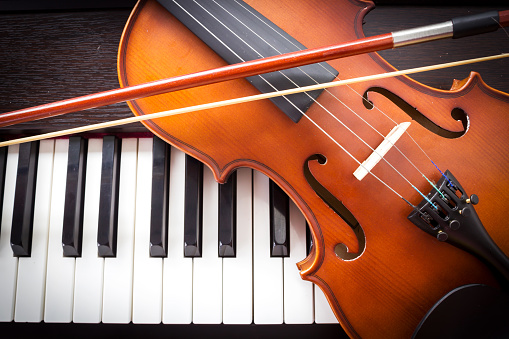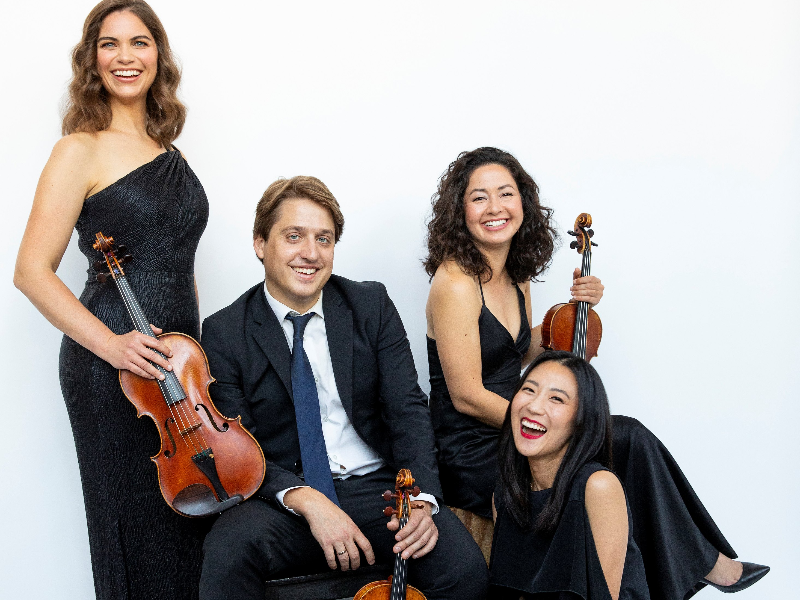THE MUSIC OF AMY BEACH & LOUISE FARRENC
Wednesday, June 7, 2023 | noon
First United Methodist Church
407 N Bridge St
LOUISE FARRENC (1804 – 1875)
Nonet in E-flat major, Op. 38
- Adagio – Allegro
- Andante con moto
- Scherzo, Vivace
- Adagio – Allegro
Rachel Woolf, flute
Ian Davidson, oboe
Vanguel Tangarov, clarinet
Daniel Chrisman, bassoon
Peter Rubins, horn
Corinne Stillwell, violin
Susan Doering, violin
Korine Fujiwara, viola
Dieter Wulfhorst, cello
Andrew Potter, bass
Faith DeBow, piano
AMY BEACH (1867 – 1944)
Piano Quintet in F-sharp minor, Op. 67
- Adagio – Allegro moderato
- Adagio espressivo
- Allegro agitato – Adagio come prima – Presto
Corinne Stillwell, violin
Susan Doering, violin
Korine Fujiwara, viola
Dieter Wulfhorst, cello
Faith DeBow, piano
See our 2023 artist list for biographical information.
When Amy Marcy Cheney was born in 1867, an American woman could not serve on juries, enter into contracts, or hold public office. Amy Beach could not vote until she was 53 years old. These limitations, and the attitudes that produced them, posed a problem for a child prodigy who started composing at age four and performing soon thereafter. Although her parents refused advice to send her to Europe to study piano and composition, she was allowed private tutelage until she was fourteen. After that, she was allowed to continue teaching herself, even translating French composer Berlioz’ (Symphonie fantastique) famed book on orchestration, so that she could hone her craft, while her piano skills flourished.
At age 18, she was married to a surgeon 24 years her senior. As part of the marriage agreement, she limited her public performances to two recitals per year. Fortunately, this allowed her to devote more time to compositions whose publication under the name Mrs. H.H.A. Beach increasingly gained her fame. Upon her husband’s death, she kept his name in the USA, but used “Amy Beach” when she toured in Europe. And she used her growing income to support charities that promoted music education for girls.
Her piano quintet (the traditional name for a chamber group for piano and string quartet) is more like a concerto for piano with chamber orchestra. The first movement is the epitome of late-nineteenth romanticism, expressing tumultuous action and high emotionalism that is almost Wagnerian.
The tumult continues in the Adagio, with its muted asymmetric phrases and passionate tragedy redolent of the atmosphere of the 1942 Bette Davis film Now Voyager. Davis’ character, Charlotte, moves away from a bullying mother, finding both her confidence and a deep romantic attachment. She nobly ends the film caring for the troubled daughter of her beloved, a married man from whom she must remain permanently separated. Beach’s 1907 quintet was decades ahead of this film. The roiling tempo changes of its final movement head toward the heroic ending, suggesting a sense of moral victory as in the film.
Born over a half century before Beach, French composer Louise Dumont Farrenc‘s talent could more easily achieve victory. Because of her gender, she was forbidden to enroll in composition classes at the famed Paris Conservatoire, but since many Conservatoire professors also taught privately, her wise and supportive parents arranged study with Antoine Reicha, then-head of the Conservatoire.
Like Beach, Farrenc married young. At 17 in 1821, she married a flutist 10 years her senior. Unlike H.H.A. Beach, however, Farrenc’s husband, Aristide, a flutist, supported her career. He later founded what would become the famed Editions Farrenc music publishing house. After touring with her husband, bearing a child, and making a name for herself as a virtuoso performer, Farrenc served for decades as “Professeur de Piano” at the Conservatoire, the only woman to hold that title throughout the century. Despite this progress, she was paid less than male professors until the runaway success of the nonet you will hear tonight. Her own self-assertion and the advocacy of a famous male violinist, Joseph Joachim (who was only 18 at the time) ultimately resulted in pay equity.
Despite injustice, Farrenc’s nonet reflects the charm typical of French music in the early half of the Romantic era. She scores the music for woodwind quintet (flute, oboe, clarinet, horn, bassoon) and four strings, not the typical string quartet of two violins, viola, and cello, but rather a violin, a viola, a cello, and a double bass.
The woodwind quintet was moving into the forefront of chamber music as a result of numerous technical changes that occurred in the materials and placement of their keys. Farrenc’s teacher, Reicha, championed this new ensemble, contributing 24 compositions.
The nonet’s opening adagio features the pastoral sound of the woodwinds then transforms into the light mood of a Mozart serenade, like Eine kleine Nachtmusik. In keeping with traditions of Haydn and even Brahms, the second movement is in theme and variations form, but in the galant style that had long been a French signature. After the elegant theme, the five variations highlight the Empfindsamer [sensitive] style, brilliant scale runs in the violin, pastoral calls in the horn, the requisite minor movement in a slower tempo, and a dancelike allegretto, leading to delicate pizzicato at the coda’s end.
The scherzo takes those pizzicato notes in a jaunty direction, interrupted by the trio section with the sounds of horns in the woods and the viola racing like a burbling brook, while the violin floats a romantic melody about the rest. When the main theme returns the bows return to the strings aiming toward the final movement. After a soothing adagio, listeners are back into the woods, returned to the hunt, just as heroic women of that era sought out and found ways to nurture and promote their talents.
–Dr. Yvonne Kendall, © 2023

Sponsors
Fred & Rhea Fry
This concert is generously supported by our concert sponsors and by donors to the Victoria Bach Festival’s Annual Fund. Many thanks to our generous supporters!
Beach and Farrenc: Heroically Shattering Glass Ceilings Before They Could Vote
When Amy Marcy Cheney was born in 1867, an American woman could not serve on juries, enter into contracts, or hold public office. Amy Beach could not vote until she was 53 years old. These limitations, and the attitudes that produced them, posed a problem for a child prodigy who started composing at age four and performing soon thereafter. Although her parents refused advice to send her to Europe to study piano and composition, she was allowed private tutelage until she was fourteen. After that, she was allowed to continue teaching herself, even translating French composer Berlioz’ (Symphonie fantastique) famed book on orchestration, so that she could hone her craft, while her piano skills flourished.
At age 18, she was married to a surgeon 24 years her senior. As part of the marriage agreement, she limited her public performances to two recitals per year. Fortunately, this allowed her to devote more time to compositions whose publication under the name Mrs. H.H.A. Beach increasingly gained her fame. Upon her husband’s death, she kept his name in the USA, but used “Amy Beach” when she toured in Europe. And she used her growing income to support charities that promoted music education for girls.
Her piano quintet (the traditional name for a chamber group for piano and string quartet) is more like a concerto for piano with chamber orchestra. The first movement is the epitome of late-nineteenth romanticism, expressing tumultuous action and high emotionalism that is almost Wagnerian.
The tumult continues in the Adagio, with its muted asymmetric phrases and passionate tragedy redolent of the atmosphere of the 1942 Bette Davis film Now Voyager. Davis’ character, Charlotte, moves away from a bullying mother, finding both her confidence and a deep romantic attachment. She nobly ends the film caring for the troubled daughter of her beloved, a married man from whom she must remain permanently separated. Beach’s 1907 quintet was decades ahead of this film. The roiling tempo changes of its final movement head toward the heroic ending, suggesting a sense of moral victory as in the film.
Born over a half century before Beach, French composer Louise Dumont Farrenc‘s talent could more easily achieve victory. Because of her gender, she was forbidden to enroll in composition classes at the famed Paris Conservatoire, but since many Conservatoire professors also taught privately, her wise and supportive parents arranged study with Antoine Reicha, then-head of the Conservatoire.
Like Beach, Farrenc married young. At 17 in 1821, she married a flutist 10 years her senior. Unlike H.H.A. Beach, however, Farrenc’s husband, Aristide, a flutist, supported her career. He later founded what would become the famed Editions Farrenc music publishing house. After touring with her husband, bearing a child, and making a name for herself as a virtuoso performer, Farrenc served for decades as “Professeur de Piano” at the Conservatoire, the only woman to hold that title throughout the century. Despite this progress, she was paid less than male professors until the runaway success of the nonet you will hear tonight. Her own self-assertion and the advocacy of a famous male violinist, Joseph Joachim (who was only 18 at the time) ultimately resulted in pay equity.
Despite injustice, Farrenc’s nonet reflects the charm typical of French music in the early half of the Romantic era. She scores the music for woodwind quintet (flute, oboe, clarinet, horn, bassoon) and four strings, not the typical string quartet of two violins, viola, and cello, but rather a violin, a viola, a cello, and a double bass.
The woodwind quintet was moving into the forefront of chamber music as a result of numerous technical changes that occurred in the materials and placement of their keys. Farrenc’s teacher, Reicha, championed this new ensemble, contributing 24 compositions.
The nonet’s opening adagio features the pastoral sound of the woodwinds then transforms into the light mood of a Mozart serenade, like Eine kleine Nachtmusik. In keeping with traditions of Haydn and even Brahms, the second movement is in theme and variations form, but in the galant style that had long been a French signature. After the elegant theme, the five variations highlight the Empfindsamer [sensitive] style, brilliant scale runs in the violin, pastoral calls in the horn, the requisite minor movement in a slower tempo, and a dancelike allegretto, leading to delicate pizzicato at the coda’s end.
The scherzo takes those pizzicato notes in a jaunty direction, interrupted by the trio section with the sounds of horns in the woods and the viola racing like a burbling brook, while the violin floats a romantic melody about the rest. When the main theme returns the bows return to the strings aiming toward the final movement. After a soothing adagio, listeners are back into the woods, returned to the hunt, just as heroic women of that era sought out and found ways to nurture and promote their talents.
–Dr. Yvonne Kendall, © 2023



